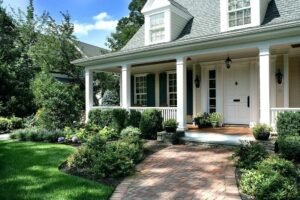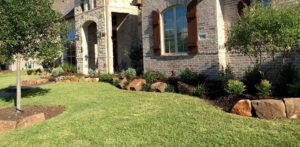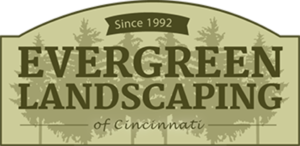You’ve got a beautiful home, but something’s missing from the yard. Maybe you’re wondering whether to go for a clean, modern landscape or lean into something a bit more timeless and classic. Each style has its charm and personality, and picking the right one isn’t just about looks. It’s about lifestyle, maintenance, functionality, and how everything ties into your home’s architecture. In this post, we’ll walk you through everything you need to know about modern versus traditional landscape design so you can decide what feels right for you and your outdoor space.
Traditional Landscape Design: Timeless Charm and Classic Comfort
If your heart leans toward lush gardens, defined walkways, and cozy, tucked-away seating nooks, traditional landscape design may be your style. Rooted in history and elegance, this approach often reflects formal patterns, symmetry, and a connection to classic architecture.
It’s the kind of yard that feels like a storybook, think brick pathways guiding you past blooming hydrangeas and garden statues standing proudly among neatly trimmed boxwoods. These landscapes are thoughtfully curated, balancing visual richness with an intimate feel. They often complement older or classically styled homes, such as Colonial or Tudor designs.
What makes traditional landscaping truly appealing is its ability to offer comfort through familiarity. Flower beds are layered and filled with seasonal color, while cozy benches and pergolas invite you to sit, relax, and enjoy the garden. It’s ideal for homeowners who appreciate charm, detail, and structure in their outdoor spaces.
Modern Landscape Design: Clean Lines and Contemporary Living
On the flip side, modern landscape design embraces simplicity, geometry, and function over flourish. Rather than intricate detail, it focuses on sleek materials, subtle colors, and minimalism. Picture a backyard with large pavers, minimalist patio furniture, and drought-resistant grasses swaying under architectural lighting.
Modern landscaping is great for those who prefer low-maintenance living and a sleek aesthetic. It works particularly well with contemporary homes and urban settings. Concrete, steel, gravel, and glass often replace traditional bricks and wooden fences, giving the space an upscale, cutting-edge vibe.
This design style is all about blending form and function. Outdoor living spaces flow seamlessly from the indoors, creating a unified experience. With smart irrigation systems and sustainable design features, modern landscapes often prioritize efficiency as much as appearance, perfect for busy homeowners who want their yards to look amazing without the heavy upkeep.
Which Landscape Is Easier to Maintain?
Here’s the truth: traditional landscaping usually takes more work. The lush gardens, seasonal plants, and ornamental shrubs are beautiful but require regular care, like pruning, fertilizing, mulching, and occasional replanting. It’s rewarding but time-consuming.
Modern landscapes, in contrast, are designed with ease in mind. Many homeowners opt for native or drought-tolerant plants like succulents or ornamental grasses, which require far less water and upkeep. With fewer plants and a simpler design, the yard needs less ongoing attention. Add in automated lighting and irrigation, and you’ve got a space that takes care of itself.
If you enjoy gardening and don’t mind getting your hands dirty, the traditional style may suit you well. But if your goal is something stylish and stress-free, modern landscaping has a clear edge.
Eco-Friendliness and Sustainability
In today’s world, landscaping isn’t just about looks—it’s also about impact. Sustainable design plays a big role, and here modern landscaping often takes the lead. Using materials like permeable pavers, capturing rainwater, and planting drought-tolerant species can reduce your environmental footprint.
Traditional landscapes can certainly be eco-friendly too. It just takes a bit more planning. Organic gardening methods, composting, and native planting can help reduce water use and promote healthy soil. But these features are more naturally built into the modern design mindset.
If you’re aiming to create an environmentally responsible outdoor space, either design style can work—as long as you’re intentional with your choices. And if you’re in the middle of a landscape renovation, this is a great time to ask your designer about incorporating sustainable elements like rain gardens or solar-powered lighting.
Budget Breakdown: What Will It Cost?
Let’s talk numbers. Traditional landscaping can come with a higher upfront cost, especially if you’re incorporating hardscape elements like fountains, statues, or custom masonry. Plants may be less expensive individually, but the amount and maintenance can add up over time.
Modern landscaping often requires a bigger investment in materials. Concrete walkways, steel edging, and custom lighting aren’t cheap, but they’re built to last. The good news? Once it’s installed, upkeep is usually minimal, which can save you money in the long run.
Ultimately, your budget depends on what features you prioritize. If you’re looking to invest in curb appeal and resale value, both styles can be effective—just be sure to factor in installation and long-term maintenance costs before making a decision.
Matching Design to Architecture: Creating Harmony
Your landscape should feel like an extension of your home, not a separate world. That’s why choosing a style that complements your home’s architecture is so important.
If you live in a Colonial, Craftsman, or Victorian-style home, traditional landscaping tends to feel right at home. It mirrors the architectural details and helps create a cohesive look that enhances curb appeal.
For modern or mid-century homes, sleek lines and minimalistic planting beds look natural and intentional. Trying to force a traditional garden onto a contemporary home can feel disjointed, and vice versa.
The goal is to create visual harmony. Walk out your front door and ask yourself: Does the outdoor space feel like an extension of what’s inside? If not, it may be time for a redesign.
Lifestyle Fit: How Will You Use Your Outdoor Space?
Before committing to a landscape style, think about how you plan to use your outdoor area. Are you hosting summer BBQs with friends or enjoying quiet mornings with a book in hand? Your daily routine should influence the design.
Traditional yards often feel more intimate and cozy, with private corners, flower beds, and shade-providing trees. They’re great for relaxation and quiet enjoyment.
Modern designs, however, tend to be more open and structured, perfect for entertaining. Think large patios, built-in seating, and fire features. It’s all about usable space.
Matching your lifestyle to your landscape style ensures you’ll actually use and enjoy your yard year-round.
Can’t Decide? Go Transitional and Get the Best of Both Worlds
If you’re torn between styles, there’s a third option: transitional landscape design. This hybrid approach blends elements of both modern and traditional landscaping for a balanced, custom look.
You might pair symmetrical planting beds with minimalist hardscaping or add contemporary lighting to a classic garden layout. The key is in the details, mix and match thoughtfully, and you’ll create something that feels personal and unique.
Transitional designs are flexible and can adapt over time, which is great if you think your style might evolve. Talk to your landscape designer about ways to merge features from both aesthetics without making the space feel cluttered.
Wrapping Up: What’s Right for You?
When it comes down to it, there’s no one-size-fits-all answer. Traditional landscape design offers timeless charm, rich textures, and a sense of comfort rooted in history. Modern design delivers clean lines, practicality, and sustainability with a forward-thinking edge. Your final choice depends on your home’s architecture, how you plan to use the space, your time for upkeep, and, of course, your taste. And if you’re still undecided, blending both styles is a perfectly valid and beautiful solution. Whatever you choose, make it yours.
FAQs
1. Is traditional landscape design outdated?
Not at all. While modern design trends are popular, traditional landscapes remain timeless and are perfect for homes with classic architecture.
2. Can modern landscaping work in small yards?
Yes! Modern design often shines in smaller spaces thanks to its focus on clean lines and efficient use of space.
3. What’s the best style for resale value?
Both styles can boost curb appeal. The key is matching your landscape to your home’s design and neighborhood aesthetic.
4. How do I transition my current yard to a new design?
Start with small updates like changing materials or adding focal features, then gradually update planting areas and layouts.
